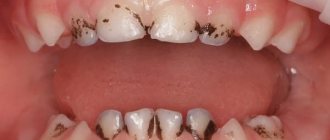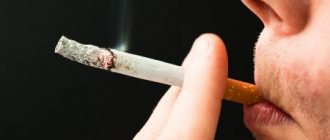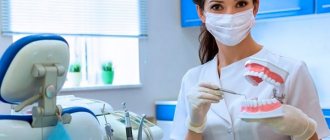What is Priestley's plaque
Plaque on baby teeth of a yellowish, black or brown color appears in a child when bacteria actively multiply in the oral cavity. Priestley's plaque is often seen at an early age, but can also occur in older children. When deposits appear, teeth lose their attractiveness, which can negatively affect the child’s psychological state. If symptoms of this unpleasant phenomenon develop, you should immediately contact your dentist to eliminate Priestley’s plaque in children.
What to do if a child has tartar?
If you discover tartar in your child, first be sure to make an appointment with a pediatric dentist. At the first visit, the little patient undergoes professional teeth cleaning: dental plaque and soft plaque are removed. Subgingival stone is removed under local anesthesia using ultrasound. After the procedure, the dentist tells parents about the need to monitor whether the child is brushing their teeth correctly. Before and after the procedure, the hygiene index is checked and the oral care rules are repeated in the presence of parents. After 1-2 weeks, an appointment is made to monitor the thoroughness of dental plaque removal
Causes of black plaque in children
The main causes of black plaque on teeth are:
- Priestley plaque is the main cause of deposits. Growing up, the child gets rid of this problem, since plaque almost never settles on permanent teeth. This phenomenon does not harm health and is characterized as a purely aesthetic defect.
- Tooth decay is a serious disease that can lead to tooth loss. The carious process is accompanied by yellowing and subsequently blackening of the tooth enamel. When the first symptoms appear, you should immediately consult a dentist.
- Dysbacteriosis is a disease that leads to the appearance of dental plaque due to disturbances in the functioning of the digestive system. The causes of the disease are poor diet, long-term use of medications, chronic diseases affecting the liver or intestines.
- Oversaturation of the body with iron. Prescribing iron-containing medications to children leads to the formation of both black plaque and deposits that are dark purple or brown in color.
In addition, teeth can darken due to a lack of calcium in the body caused by some disease. In general, the exact cause will be revealed during an examination by a dentist.
The process of tartar formation
Tartar begins its formation with the deposition of bacterial plaque of a soft consistency, which is subject to progressive calcification: calcium phosphate minerals are deposited between the bacteria in the plaque, and then they are again covered by a layer of plaque. Thus, a mineralized hard plaque appears on the teeth, mainly in the anterior section, which cannot be removed with a children’s toothbrush. In adults, the usual color of tartar is brown, but in children it is most often green. Dentists claim that such plaque occurs as a result of the activity of chromogenic microorganisms that contain chlorophyll, which, as you know, is green.
What does ignoring the problem lead to?
Failure to promptly contact a dentist when plaque appears on baby teeth leads to the following negative consequences:
- development of the inflammatory process;
- bleeding gums, which occurs if the child eats or brushes his teeth;
- the likelihood of developing diseases such as caries, stomatitis and periodontal disease increases;
- milk teeth with a black coating are very unaesthetic, which is fraught with the development of complexes in the child;
- deposits may be accompanied by bad breath.
Methods for preventing tartar in childhood
As noted above, the absence of pyrophosphate can lead to the deposition of tartar. That is why some toothpastes contain this substance. It tends to stop the process of mineralization of tartar and create an obstacle to the formation of new ones. The presence of pyrophosphate in toothpastes can slightly compensate for the lack of a natural analogue in saliva. When choosing a toothpaste with this substance, you must pay attention to the age at which it is recommended to use it.
A properly selected toothbrush for your baby will also help prevent the formation of tartar in childhood. It is better to choose brushes with artificial bristles, because, unlike natural bristles, microorganisms cannot form in them. Of course, you shouldn’t forget that your toothbrush needs to be changed every 3 months. While your child is still unable to brush his teeth on his own due to his age, you can use special napkins to clean his teeth. They contain xylitol, which inhibits the growth of bacteria on the gums and teeth and perfectly cleanses them of soft plaque. In this case, it is also important to eat fresh hard vegetables and fruits: carrots, cabbage, apples.
For more effective oral hygiene, it is extremely important to teach your child how to properly brush their teeth. The following are the most important of the dentist’s recommendations: first, the upper jaw is cleaned from the inside and outside, first from the lateral sections, and then from top to bottom the front teeth. The sequence on the lower jaw is the same, but the brush moves from bottom to top. It is imperative to remember about the hygiene of the tongue, palate and buccal mucosa, where bacteria accumulate in large quantities.
It is extremely important for parents to monitor their children’s oral hygiene and regularly visit the pediatric dentist with them. This is the only way to prevent the possibility of the formation of tartar, which can provoke various diseases of the oral cavity, for example, childhood periodontitis, gingivitis, and various types of stomatitis. Also, you will not be bothered by bad breath from your baby. Teeth that have children's orthodontic appliances on them require special care. Don't forget that soft plaque and food debris can be easily removed with a toothbrush and toothpaste. Removal of mineralized deposits on teeth is carried out exclusively by a hygienist using special instruments and means.
Preventing the reappearance of black plaque on teeth
Prevention of plaque formation includes:
- Regular dental and oral care. For babies, their gums are cleaned using cotton pads and special silicone tips. When the baby turns two years old, he needs to be taught to properly brush his teeth with a brush and toothpaste, as well as to regularly rinse after meals.
- Balanced diet. Your child's diet should include fewer sugar-laden foods and more natural fruits and a variety of vegetables.
- Timely limitation of the use of pacifiers and bottles. Long-term use of these items leads to the appearance of malocclusion, the development of a certain dependence, and the formation of so-called “bottle caries.” If a child can do without a pacifier and bottle, they should be disposed of.
In addition, you should constantly monitor the state of the child’s immune system and support it with the help of vitamins, which have a beneficial effect on the health of the teeth and the whole body. If you follow these simple recommendations, your child will always delight his parents with his beautiful and healthy smile.
Types of dental plaque in children
A qualified dentist will pay attention not only to the presence of hard deposits in the child, but also to their nature.
Tartar is classified according to its location into two types.
- Supragingival. Plaque accumulation occurs on the surface of the tooth and can be visually seen. It has a pale yellow or gray color. Mostly such deposits do not consist of bacteria, but of minerals contained in saliva. The lower anterior teeth and upper molars are most commonly affected.
- Subgingival. Tartar is difficult to see because it forms in subgingival pockets. It also contains minerals, but they come not from saliva, but from the gingival fluid. The deposit is dark brown in color with a faint greenish tint. The initial plaque is localized at the root zone, in the gingival grooves, on the neck of the tooth or in the periodontal pocket.
The method of removing tartar in children is determined depending on the type of deposits. It is easier to clean a tooth from supragingival plaque than to remove subgingival deposits.
Causes of white spots on teeth
It is important to correctly determine what caused the negative changes in order to choose the optimal treatment tactics. The appearance of spots can have a clear relationship with the current level of health and living conditions of the child or be associated with defects in intrauterine development - this is when the rudiments of teeth are formed. This process is influenced by the physiological state, nutrition of the mother and her intake of certain medications during pregnancy. Difficult pregnancy, toxicosis, poor nutrition, smoking, taking tetracycline antibiotics - all this can cause congenital hypoplasia (underdevelopment) of enamel [3].
Injury to teeth from a fall or impact during the process of formation and eruption of baby or permanent teeth can also cause uneven coloring.
One of the common causes of stains on teeth is excess fluoride in a child’s body. Typically, excess of its concentration occurs due to the characteristics of water quality in a particular geographic region, excessive artificial fluoridation of water, or due to the use of toothpaste by a child that is not intended for children [4].
If the amount of fluoride in tap water is more than required, more than the norm, then children who live in this area and drink this water are not recommended to use pastes containing fluoride until the age of 5. Selyutina
Yu.I., member of the International Association of Pediatric Dentists IAPD, winner of the federal competition of pediatric dentists in Russia, pediatric dentist, writer, blogger, founder of the author’s Center for Dentistry[5]
White spots on teeth may also indicate the beginning stages of caries . While negative changes are only in the surface layers of the tooth, they can be stopped and completely eliminated if you consult a specialist in a timely manner.
Another risk factor is correcting the bite by wearing fixed orthodontic appliances. This can also cause white spots on temporary or permanent teeth.
The sudden appearance of white spots can also be a signal of serious internal changes and requires examination and consultation with specialists.
Methods for removing tartar
The dental procedure for removing tartar from teeth is painless and safe. This can be a separate manipulation or a stage of professional cleaning of tooth enamel.
Removal of supragingival tartar can be performed by two methods:
- hygienic cleaning - with professional toothpaste and a special brush;
- Airflow method - a hardware technique for cleaning teeth with soda crystals flowing through a nozzle under pressure with an air flow).
It is more difficult to get rid of subgingival deposits, so more effective methods are used:
- manual cleaning - the doctor uses a tool to separate the tartar from the enamel;
- ultrasonic cleaning - deposits are destroyed by ultrasonic waves and then removed with a tool.
The procedure is completed by polishing the tooth. To strengthen damaged tooth enamel, a remineralizing composition and fluoride varnish are applied to the surface of the tooth.










